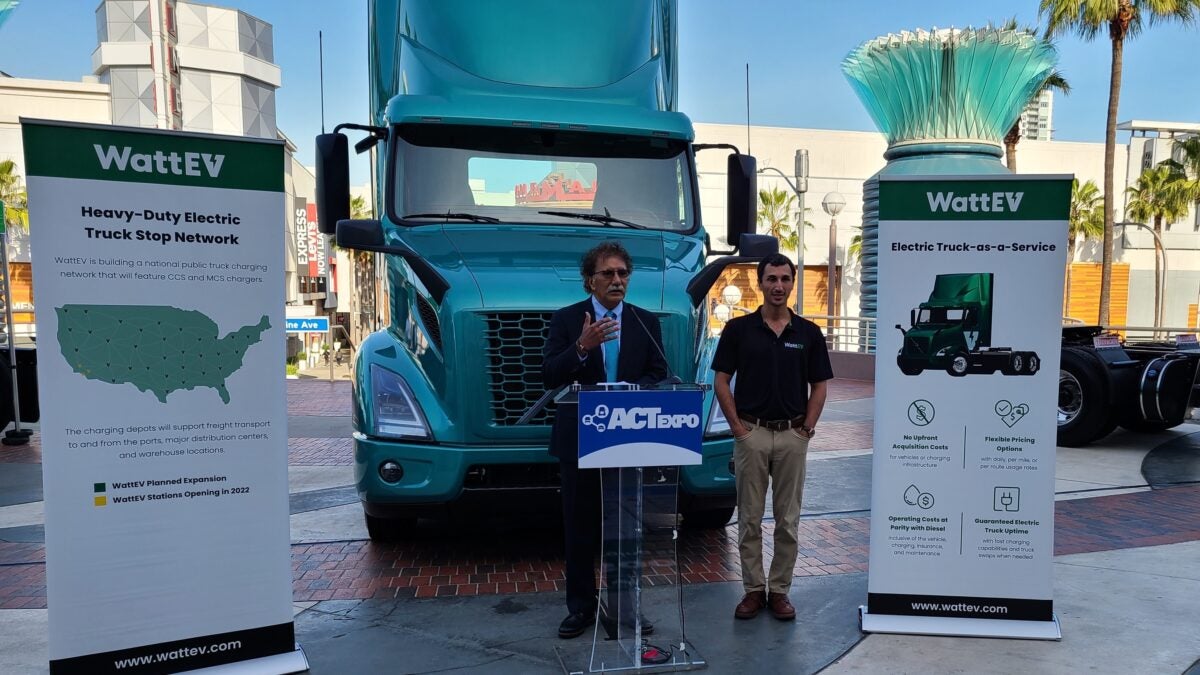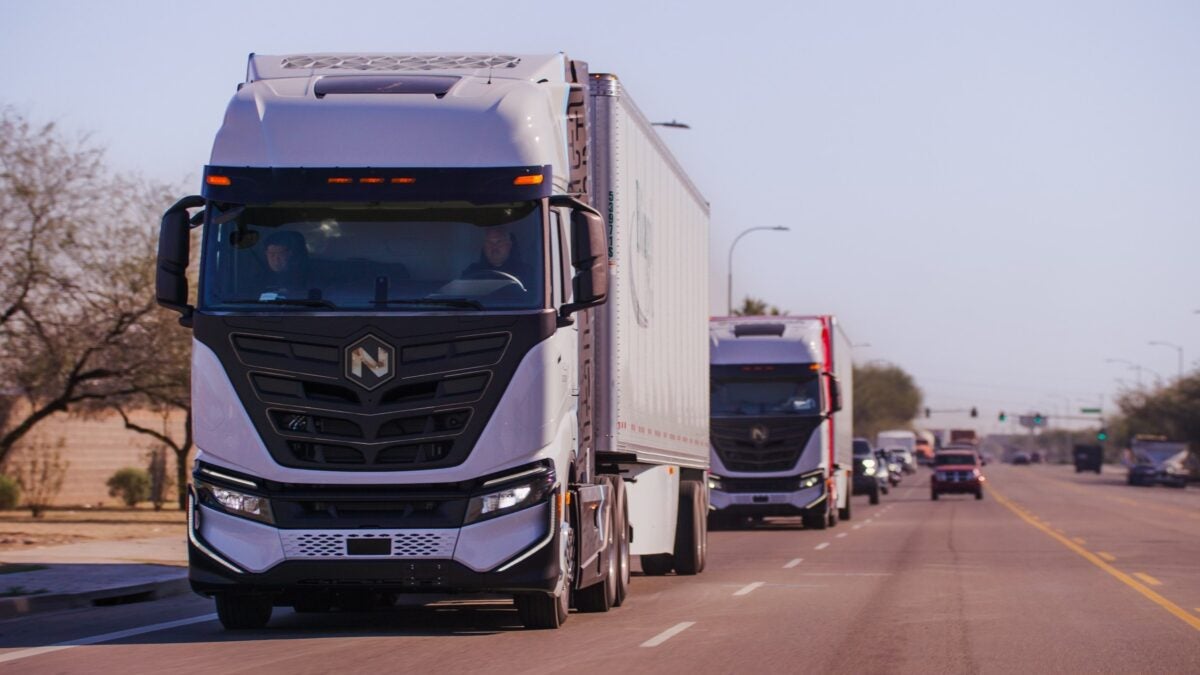California and its generous voucher program and subsidies available through the Inflation Reduction Act provide a comfort zone for electric truck purchases that wouldn’t exist without them.
How long will incentives be needed? It’s going to be awhile.
“We definitely need the incentive money right now to help lower the cost,” Salim Youssefzadeh, CEO and founder of startup Truck-as-a-Service WattEV, told me. “Long term, we have to see prices of these trucks come down. We have to see prices of the charging equipment come down.”
That requires economies of scale. At least 1,000 Class 8 electric trucks, he said. But it’s probably more than that.
Volvo Trucks North America, Paccar and Daimler Truck North America are building Class 8 electric trucks on regular production lines now. Daimler’s is a dedicated line in Portland, Oregon. Orders are coming in, but practically none without a point-of-sale spiff of as much as $168,000 from the Hybrid and Zero-emission Truck and Bus Voucher Incentive Project (HVIP).
“Right now, an electric truck is four times that of a diesel,” Youssefzadeh said. ”Even after you apply HVIP, it’s two times as much. So they’re still way too expensive to get owner-operators involved.”
Food delivery company US Foods said this week it is adding 30 subsidized electric trucks to its fleet this year. The first was a Freightliner Class 8 eCascadia. Rival Sysco Corp. signed a letter of intent in May for up to 800 eCascadias by 2026.

Incentives help meet medium-duty TCO
Tim Krauskopf, CEO of medium-duty electric truck maker Motiv Power Systems, thinks dependence might be too strong a word to describe the state of electric truck incentives. He prefers highly influenced. Yet four of the last six blog posts on the company’s website talk about HVIP. For its part, HVIP’s website says it has subsidized 11,000 electric vehicles to date with an average savings of 20%.
“We did really well in the California HVIP tranche of 2022,” Krauskopf told me at the recent Manifest supply chain conference in Las Vegas. More than 175 Motiv Class 5 and 6 step van purchases received vouchers of about $60,000 each.
Adding the IRA incentive of $40,000 per vehicle, the total cost of ownership math for medium-duty electric trucks becomes compelling.
“We have calculations that show for a step van, we are at a comparable TCO when you throw that $40,000 in. If you add a California $30,000, $40,000, $50,000 or $60,000, you are better off getting the EV,” he said. “They still cost 1½ to over two times the ICE [internal combustion engine] equivalent. But we’re trying to push that down, and you save a lot of fuel.”

Pricier hydrogen trucks qualify for bigger incentives
When it comes to pricier hydrogen-powered fuel cell trucks, bigger incentives apply. Nikola Corp.’s fuel cell electric truck qualifies for up to $288,000 per truck in HVIP money, and it meets the criteria for the IRA incentive. Nikola suggests that shaves 40% to 70% off the price. Converting letters of intent to purchase orders depends on getting all available incentives.
“It’s great news because the support is significant,” Michael Lohscheller, Nikola CEO and president, told me. “The reality of life is new technology is very expensive. It’s very helpful to have this for a few years to make sure that we really transition.”

Platform Science tips the scales
Bypassing truck weighing stations is nothing new. Electronic verification of safety, credentials and weight, such as what PrePass offers, is readily available.
Now comes Platform Science, which is rapidly finding its connected vehicle platform on more OEM trucks, most recently Kenworth and Peterbilt.
Platform Science is collaborating with CAT Scale, a leading truck scale network, to offer CAT Scale’s Weigh My Truck and CAT Scale Locator apps that makes it easier for commercial vehicle fleets to develop, deploy and manage mobile devices and applications.
The Weigh My Truck app allows drivers to weigh and then get the weights displayed on their mobile device without leaving the cab. The app will also email a locked PDF copy of the scale ticket to email addresses a driver specifies.
The CAT Scale locator app allows drivers to locate the nearest CAT Scale locations on their mobile devices, plan their routes based on their current locations and save CAT Scale locations.
Uptake signs OEM for predictive maintenance service
Software-as-a-service provider Uptake is selling its preventive maintenance technology to Daimler Truck North America. The data mining service Uptake Fleet watches for 168 things that can wear out on a truck and lets the fleet know before it happens. That saves money on stocking parts for something that might happen.
When customers consent, DTNA will facilitate streaming of the necessary truck data it already collects to power Uptake Fleet. By analyzing information from subsystem sensors and work orders, Uptake can predict vehicle problems before a fault code and recommend what to do before costly repairs, delays or roadside breakdowns result.
Uptake points to parts shortages, trucks staying in service longer because of production shortfalls and rising maintenance costs as rationale for using insights from its 65 data science models.
“Daimler Truck North America is committed to using cutting-edge technologies so our customers can get the longest and most impactful life from their vehicles,” Sanjiv Khurana, general manager of digital vehicle solutions at DTNA, said in a news release.
“It is encouraging that Uptake is exploring new ways of leveraging data to optimize the performance of our trucks, and we are excited to explore the potential this brings.”
Plus mum on taking another swing at public ownership
The first time autonomous truck software developer Plus tried to go public, the effort failed because of nervousness over China’s crackdown on U.S. listings of technology companies with Chinese ties.
The startup may be getting ready to try again, according to a report on Chinese technology website Pandilly.
According to the report, Plus in March would merge its Chinese business into Full Truck Alliance, a digital freight platform.
Separating its Chinese and U.S. businesses could avoid the scrutiny from the Committee on Foreign Investment in the United States that rival TuSimple is still experiencing.
Plus told FreightWaves it had no comment on the report.

That’s it for this week. Thanks for reading. Click here to receive Truck Tech via email on Fridays. And tune in to Truck Tech on FreightWaves TV on Wednesdays. Alex Rodrigues, co-founder and CEO of Embark Trucks, will be our guest on March 1.








Robert Cooper
How about let the free market work out what is most cost effective for a fleet to operate rather than artificially propping up one particular type of truck over another? I’m tired of my tax dollars being used to pick winners and losers while I work hard to make ends meet without any help from the government.